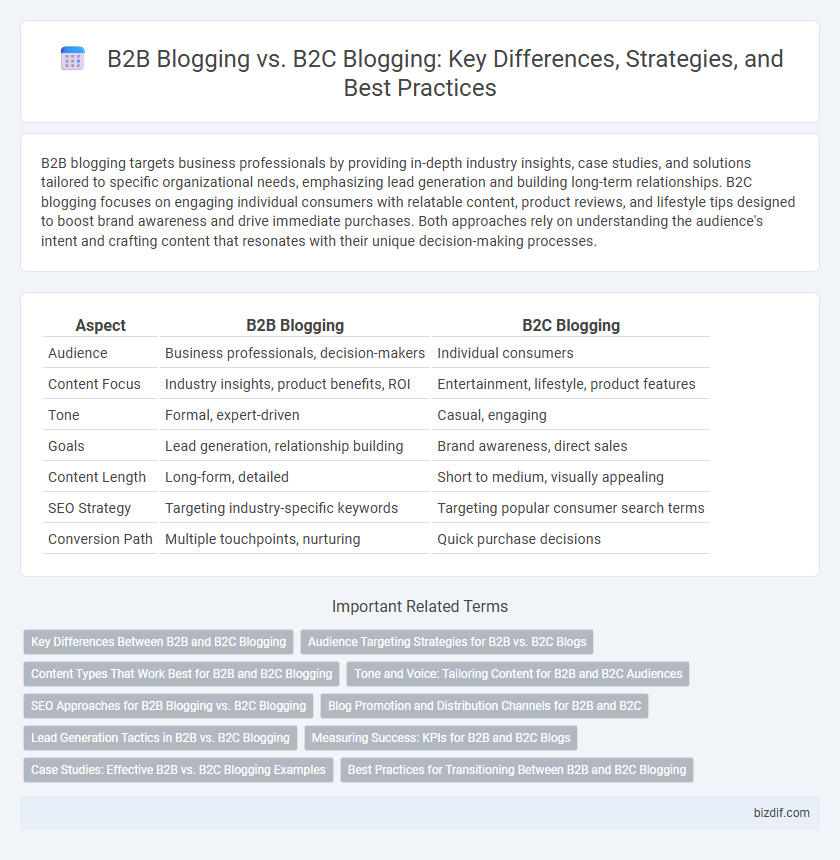B2B blogging targets business professionals by providing in-depth industry insights, case studies, and solutions tailored to specific organizational needs, emphasizing lead generation and building long-term relationships. B2C blogging focuses on engaging individual consumers with relatable content, product reviews, and lifestyle tips designed to boost brand awareness and drive immediate purchases. Both approaches rely on understanding the audience's intent and crafting content that resonates with their unique decision-making processes.
Table of Comparison
| Aspect | B2B Blogging | B2C Blogging |
|---|---|---|
| Audience | Business professionals, decision-makers | Individual consumers |
| Content Focus | Industry insights, product benefits, ROI | Entertainment, lifestyle, product features |
| Tone | Formal, expert-driven | Casual, engaging |
| Goals | Lead generation, relationship building | Brand awareness, direct sales |
| Content Length | Long-form, detailed | Short to medium, visually appealing |
| SEO Strategy | Targeting industry-specific keywords | Targeting popular consumer search terms |
| Conversion Path | Multiple touchpoints, nurturing | Quick purchase decisions |
Key Differences Between B2B and B2C Blogging
B2B blogging centers on delivering detailed industry insights, professional expertise, and solutions that address business challenges, targeting decision-makers and influencers within organizations. B2C blogging emphasizes engaging, emotional storytelling and product benefits to capture consumer attention and drive immediate purchasing decisions. Content tone varies significantly, with B2B favoring formal, data-driven language, while B2C opts for conversational, persuasive communication.
Audience Targeting Strategies for B2B vs. B2C Blogs
B2B blogging prioritizes targeting niche audiences comprising industry professionals, decision-makers, and stakeholders by creating in-depth, data-driven content that addresses business challenges and ROI-focused solutions. In contrast, B2C blogging focuses on broader, emotion-driven content tailored to individual consumers' preferences, lifestyles, and immediate needs, often utilizing storytelling and visual engagement strategies. Effective audience targeting for B2B blogs hinges on thought leadership and educational value, while B2C blogs rely on engagement metrics like shares and comments to gauge success.
Content Types That Work Best for B2B and B2C Blogging
B2B blogging thrives on in-depth whitepapers, case studies, and detailed industry analyses that demonstrate expertise and build credibility with decision-makers. B2C blogging excels with engaging storytelling, product reviews, and visually appealing content like videos and infographics that resonate emotionally with a broad consumer audience. Tailoring content types to the specific needs and preferences of B2B or B2C audiences enhances engagement and conversion rates significantly.
Tone and Voice: Tailoring Content for B2B and B2C Audiences
B2B blogging employs a professional, authoritative tone that prioritizes detailed, data-driven insights to build trust and credibility with decision-makers, while B2C blogging opts for a conversational, emotive voice designed to engage and resonate with individual consumers. Tailoring content for B2B audiences involves emphasizing industry jargon, case studies, and ROI metrics, whereas B2C content focuses on storytelling, brand personality, and emotional triggers to foster loyalty and drive purchases. Understanding these tonal distinctions is crucial for effective content marketing strategies in both sectors.
SEO Approaches for B2B Blogging vs. B2C Blogging
B2B blogging SEO strategies emphasize detailed, industry-specific keywords and long-form content that targets decision-makers and addresses complex pain points, enhancing lead generation and nurturing. B2C blogging SEO focuses on broader, high-volume keywords and engaging, easily digestible content that drives traffic and encourages quick conversions. Understanding search intent differences allows B2B blogs to rank for niche terms while B2C blogs optimize for mass appeal and brand awareness.
Blog Promotion and Distribution Channels for B2B and B2C
B2B blogging relies heavily on LinkedIn and industry-specific forums for blog promotion to reach professional audiences and decision-makers, often using email newsletters and whitepapers to distribute content. B2C blogging prioritizes social media platforms like Instagram, Facebook, and Pinterest for broader audience engagement, utilizing influencer collaborations and paid ads to drive traffic. Effective blog distribution channels vary significantly between B2B and B2C due to differences in target demographics and content consumption habits.
Lead Generation Tactics in B2B vs. B2C Blogging
B2B blogging emphasizes lead generation through in-depth whitepapers, case studies, and gated content that addresses complex business challenges, attracting decision-makers and fostering long-term relationships. B2C blogging leverages engaging storytelling, social media integration, and influencer partnerships to drive immediate customer engagement and impulse purchases. Both strategies require tailored content that aligns with audience intent, but B2B prioritizes educational resources while B2C focuses on emotional connection and brand loyalty.
Measuring Success: KPIs for B2B and B2C Blogs
Measuring success in B2B blogging primarily revolves around lead generation, conversion rates, and long-term engagement metrics like newsletter sign-ups and content downloads. In contrast, B2C blogging emphasizes immediate consumer actions such as website traffic, social shares, and sales conversions. Both strategies benefit from tracking bounce rates and time on page, but aligning KPIs with the purchasing cycle is crucial for optimizing content impact.
Case Studies: Effective B2B vs. B2C Blogging Examples
Case studies reveal that B2B blogging emphasizes in-depth industry insights, thought leadership, and detailed problem-solving content to attract decision-makers and build trust over longer sales cycles. In contrast, B2C blogging prioritizes engaging storytelling, emotional appeal, and rapid interaction to drive immediate consumer action and brand loyalty. Effective examples include B2B blogs like HubSpot's marketing guides that offer comprehensive solutions, while B2C blogs such as Glossier's lifestyle content focus on creating relatable, shareable experiences.
Best Practices for Transitioning Between B2B and B2C Blogging
Successful transition between B2B and B2C blogging requires tailoring content strategies to distinct audience needs, focusing on decision-maker insights in B2B and emotional appeal in B2C. Incorporate data-driven approaches by analyzing user behavior and engagement metrics specific to each sector, ensuring relevance and higher conversion rates. Utilize personalized messaging and adaptive SEO techniques to bridge content gaps and maintain brand consistency across both business and consumer markets.
B2B blogging vs B2C blogging Infographic

 bizdif.com
bizdif.com